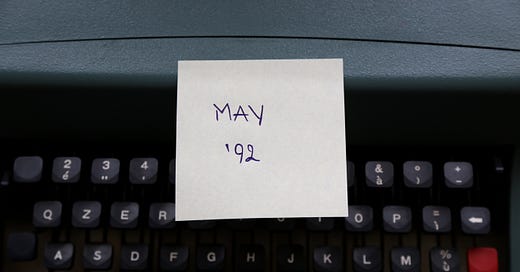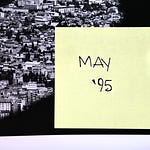It is May 1992.
The war in Bosnia and Herzegovina has officially broken out, with the siege of Sarajevo beginning on April 5 [you can listen to the latest episode of BarBalkans - Podcast here].
The defenders try to prevent the Yugoslav People’s Army (JNA) and Serbs of Bosnia militia from conquering the city center, while massacres spread throughout the Republic.
International powers are blown away by a conflict that they were not able to foresee and that creates divisions on its interpretation.
All elements that deepen the armed crisis in Bosnia, delaying the Western world response to Belgrade.
The battle of Sarajevo
What happens in the first days of May is a full-scale assault on the Bosnian capital.
Serbian soldiers descend from the surrounding hills from three different directions, to cut Sarajevo in two and to isolate the city center.
Despite some military advances, the besiegers are defeated in the Pofaliči district, the first real battle between the Territorial Defense and the Serb- and Montenegrin-dominated JNA.
The plan for a blitzkrieg in Bosnia fades away.
In the meantime, the President of Bosnia, Alija Izetbegović, is particularly exposed to the attack.
On his way back from the failed Lisbon peace talk on a European Community plane, he is taken hostage by Serbian soldiers, as soon as he lands at Sarajevo Airport.
After two days of tough negotiations, Izetbegović is freed in a hostage exchange with the commander of the JNA army corps in Sarajevo, Milutin Kukanjać.
Before the release of hostages, Sarajevo defenders seize from Kukanjać’ office many official documents demonstrating the details of the Ram Plan. Destabilization and disintegration of Bosnian institutions included.
However, international public opinion does not follow the events outside Sarajevo.
In Bosnian Krajina, the beginning of May coincides with a wave of mass killings and expulsions of non-Serb population.
Muslim and Croatian villages are sacked and razed to the ground, especially in the area of Banja Luka and Prijedor, while about 50 thousand Bosnians of the “wrong” ethnic group end up in concentration camps.
In particular, in the reception center - as it is called one of the most infamous concentration camps - of Luka (Brčko), soldiers and paramilitaries massacre an indefinite number of Bosniaks and Croats of Bosnia.
But not everything runs smoothly for Belgrade’s soldiers. In Tuzla, in North-Eastern Bosnia, the population repels an attack aimed at the conquest of the mining industries.
Even outside the Bosnian capital, Serbian blitzkrieg is only a chimera.
On May 4, Bosnia and Herzegovina declares the Yugoslav Republic as the aggressor and asks for international aid, through an armed intervention.
For defenders, the situation is complicated also by Croats of Bosnia’s attitude.
Not all of them, of course. Those living in Northern Bosnia and Posavina seek alliances with Bosniaks against Serbian violence. Those living in Western Herzegovina, ethnically compact and fanatical nationalists, look to their motherland Croatia for reunification.
The most representative voice of these people is the leader of the Croatian Democratic Union of Bosnia (HDZ), Mate Boban.
On May 6, he meets with the President of Republika Srpska, Radovan Karadžić, during the Conference in Graz.
Here, they discuss the division plan of Bosnia between Greater Serbia and Greater Croatia, following what was widely agreed between the two Presidents of Croatia and Serbia, Franjo Tuđman and Slobodan Milošević.
Bosniaks feel betrayed by Croats of Bosnia and the first armed clashes between the two ethnic components happen.
The wave of indignation reaches the United States, where The Washington Post compares the agreement between Tuđman and Milošević to Hitler-Stalin Pact. In 1939, the partition of Poland was on the table, today the partition of Bosnia.
Unbalanced military forces
Despite the collapse of the Serbian dream of a blitzkrieg in Bosnia, the situation on the field is definitely unbalanced.
After its formal establishment on May 20, the Armed Forces of Bosnia and Herzegovina can count on 75 thousand volunteers (led by Bosnian Šefer Halilović and, as deputy commanders, Croatian Stjepan Siber and Serbian Jovan Divjak).
But there are not enough guns to arm them. On the opposite front, the armed forces are ten times more significant. Tanks, armored vehicles, military vehicles and howitzers are almost absent in Bosnian arsenals, while those of the opposing army corps are well supplied.
In Sarajevo there are only 6 semi-automatic precision rifles, against 285 of Serbian besiegers.
Actually, it would be more accurate to talk about the Army of Republika Srpska. Because on May 4, Milošević puts an end to Tito’s army, disbanding the JNA (officially on May 20) and recalling the soldiers of the Federation from Bosnia.
In reality, they only change their uniforms and enlist in the new Army of Republika Srpska, also composed of former paramilitary members of Karadžić’ Serbian Democratic Party. And they receive 70 per cent of the weapons belonging to the JNA.
The head of the Serbs of Bosnia military apparatus is Ratko Mladić, the “Butcher of Bosnia”, known for the battles in Croatian Krajina and now general of the Army of Republika Srpska.
His motto is «blow the brains out» of Sarajevo citizens.
Paradoxically, on the same day in which Mladić is appointed commander of the aggressor army in Bosnia (May 15), the international bodies begin the bureaucratic and cumbersome search for a solution to the crisis.
The UN Security Council approves Resolution 752, asking the JNA to withdraw from Bosnia or to submit to Bosnian authorities.
But formally, the JNA is no longer present in Bosnia, because the Army has disbanded. Milošević’ sleight of hand has succeeded, helped by the Western Embassies’ poor knowledge of the situation on the ground.
Part of responsibility lies with the UN Secretary General, Boutros Boutros-Ghali, who sees no role for the Blue Helmets in Bosnia and rejects the request for a peacemaking operation.
The United Nations and the Western governments shift their attention from Serbian aggression against Bosnia and Herzegovina to the «humanitarian aspects of the crisis».
The political will of some countries (France, Great Britain, Russia and China) is clear: to keep the United States away from an «European domestic problem». And they do not want to recognize that this problem is an armed aggression.
The action taken - as a humanitarian response - is using Sarajevo Airport to establish an air bridge run by peacekeeping forces.
However, after an attack on May 14, the UNPROFOR headquarters is moved from Sarajevo to Belgrade, leaving only a hundred Blue Helmets in the Bosnian capital.
The same is done by the UN High Commission for Refugees (which defines the crisis in Bosnia «worse than Cambodia and Mozambique») and also the International Red Cross, after the killing of the head of mission while escorting a convoy of food.
Sarajevo is abandoned by Bosnian intellectuals, politicians and professionals. Their void is filled by Muslim refugees from the Sanjak and Eastern Bosnia.
The power remains in the hands of a few Bosniaks close to President Izetbegović, who will be in charge of managing donations from Arab countries for the defense of the Republic: 10 billion German marks, also in offshore accounts.
Dying while buying bread
The turning point comes in the second half of the month.
On May 18, Mladić’ troops bombard Sarajevo with great intensity. They deliberately destroy the Oriental Institute, with its more than 5 thousand precious Arabic, Persian, Turkish, Jewish and Bosnian-Ottoman manuscripts.
The attempt to annihilate the city culminates in the massacre of May 27.
At 9 a.m. about 200 Sarajevans are on the standing line to buy bread in front of the Markale market, in the city center. They trust the truce promised by the Serbs of Bosnia.
From the surrounding hills, three howitzer shots are fired. Twenty-five citizens die and more than 100 are wounded. And the snipers continue to fire on the rescuers.
A Sarajevo TV crew arrives immediately at the market, filming the scene in all its harshness. This is how international public opinion can see what is happening under Mladić’ bombardments.
It is called the “CNN effect” (US all-news TV channel), so powerful is the impact of the images broadcasted all over the world.
The political reaction of the Western world against Serbian Yugoslavia is heavy.
On May 30, the President of the United States, George H. W. Bush, issues an order to freeze all assets of Serbian and Montenegrin governments’ members in the country.
The same day the UN Security Council introduces a sanctions regime against the Federal Republic of Yugoslavia, through Resolution 757.
The motivation is the failure to comply with the previous Resolution 752, that ordered the withdrawal of federal troops from Bosnia two weeks earlier.
Belgrade is banned from the international community: sanctions involve international trade, air traffic, collaborations in sports, culture and science.
Resolution 757 establishes a security zone around Sarajevo Airport, in order to allow the flow of humanitarian aid. NATO is also charged with organizing a maritime monitoring operation in the Adriatic Sea.
However, what remains behind the scenes - but not for long - are the tensions between the US and European allies, in particular with France and the United Kingdom.
In order to convince the two countries (both with veto power in the UN Security Council) to vote in favor of the Resolution, Washington makes two not irrelevant concessions.
First of all, the Federal Republic of Yugoslavia is not definitively denied the status of exclusive successor of the Federation that belonged to Tito.
And then, Serbs of Bosnia are not sanctioned and they can continue to have access to international markets and even to foreign arms supplies.
All tensions and cracks between partners that will indirectly contribute to the escalation of the conflict in Bosnia and in Sarajevo.
If you liked this article, you can spread this parallel journey and the free weekly newsletter:
If you know someone who can be interested in this newsletter, why not give them a gift subscription?
Here is the archive of BarBalkans - Podcast:
And here the summary of 1991.





















Share this post